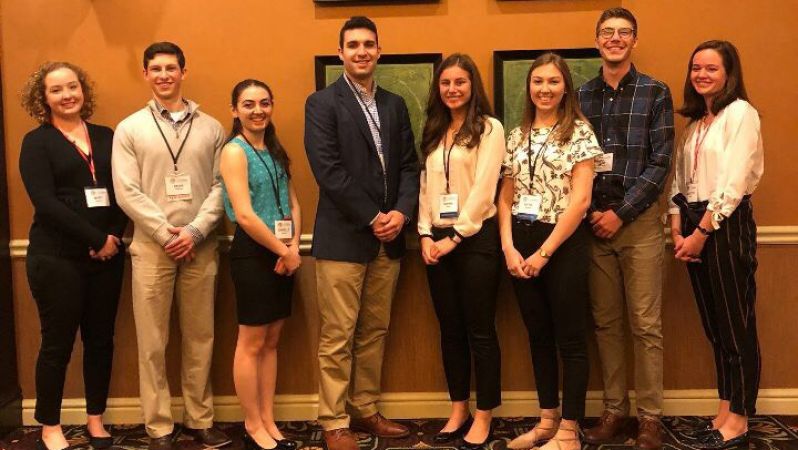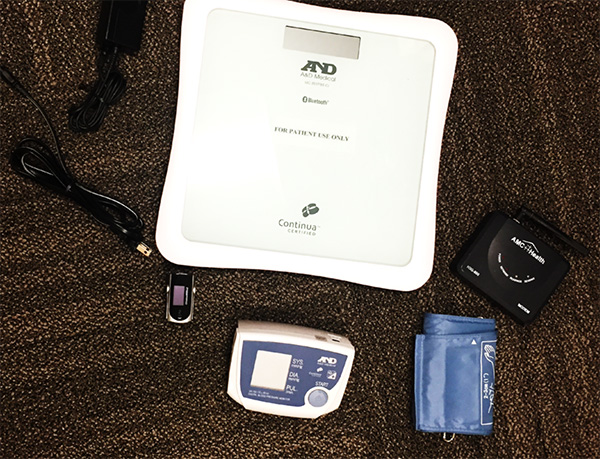IBE students work with health network to expand use of remote patient monitoring systems

Imagine a smart bandage that delivers drugs and monitors wound healing. A virtual reality setup that provides personalized, at-home physical therapy to a recovering stroke patient. Or a hearing aid that interfaces with face-recognition technology to protect the personal safety of an elderly user.
Far-fetched? Perhaps. But they’re ideas within the realm of possibility according to a March 2019 government report on “Emerging Technologies to Support an Aging Population.” With the U.S. Census Bureau predicting that a quarter of the population will be 65 or older by 2060, the research by the National Science & Technology Council seeks to guide public and private R&D efforts around enhancing the “independence, safety, well-being, and health of aging adults” while also cutting costs.
Although it may be years before we see such cutting-edge solutions become reality, the health care industry is increasingly tapping into new tech—particularly the Internet of Things (IoT)—to help more people successfully “age in place.”
That’s the case with Lehigh Valley Health Network (LVHN), which recently enlisted a team of eight Integrated Business and Engineering (IBE) students from Lehigh to evaluate and expand its use of remote patient monitoring to help keep people in their homes as they get older and face health challenges.
 LVHN’s existing system transmits vital signs collected from a scale, blood pressure cuff, and pulse oximeter (used to measure the oxygen level in blood) via Bluetooth. Nurses review the data to determine whether it falls within certain limits. Measurements outside the acceptable range trigger a follow-up call to ensure that the patient is taking medications as prescribed and determine if a visit to a doctor or hospital is in order.
LVHN’s existing system transmits vital signs collected from a scale, blood pressure cuff, and pulse oximeter (used to measure the oxygen level in blood) via Bluetooth. Nurses review the data to determine whether it falls within certain limits. Measurements outside the acceptable range trigger a follow-up call to ensure that the patient is taking medications as prescribed and determine if a visit to a doctor or hospital is in order.
Remote monitoring systems have been proven very successful, says Pat Costa, a professor of practice in IBE and primary instructor for IBE’s senior capstone design program.
“With daily monitoring,” Costa says, “health care providers can intervene sooner and avoid a bad outcome,” as well as reduce costs related to hospital readmittance.
Although LVHN’s system was previously employed for only the highest risk patients, such as those with congestive heart failure, diabetes, or chronic obstructive pulmonary disease (COPD), team member Sophia Parola ’19, an IBE industrial systems and engineering and finance double major, says the network was looking for ways to make remote monitoring feasible for use by family members and caregivers of older adults.
The main goal of the yearlong capstone project, Parola says, was to incorporate more user-friendly, less expensive technology. Doing so would allow people at risk of chronic diseases to take advantage of the service, in conjunction with their existing health care, and give LVHN the opportunity to step in before a patient’s health worsens.
Juliette Smith ’19, an IBE finance major, says the team also found that families who lived far from older family members were interested in this type of monitoring device to provide reassurance about a loved one’s health.
Increasing communication, controlling costs
The students’ solution to expanding access to the technology, Smith says, was to integrate the monitoring with a BYOD—bring your own device—system. That way, patients could use devices they already own or could easily purchase, such as an Amazon Echo or a Fitbit.
“It was about leveraging things people might already have in their homes to help them stay in their homes as they age or as their health deteriorates,” Parola says.
The students investigated other potential in-home devices and even “smart” pillboxes that remind the user to take medication.
Through their extensive research, the IBE team compiled recommendations for relatively inexpensive smart devices, including home devices, wearable technology, and traditional health devices, that were compatible with LVHN’s systems.
The capability to consistently monitor would also increase communication between LVHN staff and more of their patients, Parola says. Typically doctors see their patients only a few times a year, she says, and they don’t know much about what’s going on between appointments.
“Within three or four months a lot can change and you can end up going into the hospital and the doctor won’t even know,” Parola says. The doctors “don’t have any real source of contact other than when the patient is seeking help.”
Although the devices would come at a financial cost to patients, the overall impact of identifying severe health problems earlier would more than likely outweigh the price.
Shades of a startup
Because of their diversity in experience and majors, the students split into three subgroups: a business development team to look at pricing of the products and marketing, a technology team to investigate at various devices and their prices to find the most inexpensive devices for users, and a health care group to research the needs of providers and their goals for the device.
Other team members included Danielle Rafanelli ’19, an IBE chemical engineering major; Adam Rahim ’19, an IBE mechanical engineering and finance double major; Tim Molino ’19, an IBE finance major; Katie Shreero ’19, an IBE industrial and systems engineering major; Dean Paparian ’19, an IBE industrial and systems engineering major; and Mary Newport ’19, an IBE materials science and finance major.
To get up to speed on the state-of-the-art technology available for remote patient monitoring, the team attended the Mid-Atlantic Telehealth Resource Center 2018 Annual Summit. They also visited nursing homes and asked in-home health care providers to identify the most valuable product features.
LVHN has a close relationship with the IBE students. In the past four years, seniors have conducted five projects with the network.
“It was really interesting to have that leverage of a big organization that has that many resources and that many moving points with it,” Parola says. “We had to meet with a lot of people to make sure we were covering all of our bases.”
At the same time, Costa points out, the assignment had the flavor of a startup.
“The mission in capstone is to learn how to address technical issues in a business context from an entrepreneurial focus,” Costa says. “So even though Lehigh Valley Health Network is a major health care provider in the area, what they wanted to do was new for them.”
Story by Madison Hoff '19, a student writer for the P.C. Rossin College of Engineering and Applied Science

